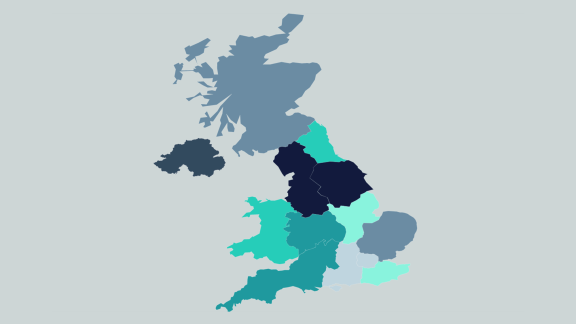Allied Health Professional apprenticeships

There are a number of degree apprenticeship routes available for individuals to train in different Allied Health Profession (AHP) occupation areas. Employers have started to use this pathway to enhance their workforce supply. Here are a number of examples from employers in the NHS about how they have implemented these roles within their organisations.
Diagnostic radiographer degree apprenticeship – University Hospitals of North Midlands NHS Trust
University Hospitals of North Midlands NHS Trust (UHNM) introduced its first cohort of three diagnostic radiographer apprentices in March 2020. The trust began using AHP apprenticeships because of the different way in which they train. It really worked for them as the apprentices were employed by the trust, meaning there was extra staffing resource in the department when required and more flexibility to deliver the training.
The apprentice radiographers follow a similar pattern of study to student radiographers at university, apart from that they are in the department for the majority of their time. Through learning on the job, they receive in-depth opportunities to learn about the equipment and how to use it, the patient care skills that should be expected, the legislation that applies to their practice and how to maintain standards.
The apprentices work in the department alongside the radiographers on a daily basis and are released for study one day per week. They will be ready to join the workforce full-time when they qualify, as they’ve spent so much time in the work setting. For the trust, this will mean a shorter induction period and smoother transition, which is a huge advantage to departments like this.
This apprenticeship provides another avenue for UHNM to develop a career path for its existing staff. The three apprentices in the first cohort were already employees of the trust within the department, so they already had imaging experience, knew exactly what they were getting in to and already loyal to the department with a genuine interest to work for the trust when they qualify.
The trust has reserved three more apprenticeship places for March 2021 and is hoping that it can continue for the next couple of years. It is part of its workforce plan and feels logical to always have three diagnostic radiographers qualifying every year at the same time that feed directly into employment. The advantage with them qualifying in the March is that this coincides with when the trust notices vacancy rates rising.
The apprentices do their study with the University of Exeter. It is a distance learning course and as such there haven’t been many challenges due to COVID-19 and it has actually allowed the provider and apprentice to get up to speed with distant education. As the AHP apprenticeships are still relatively new, the number of university providers is currently limited, so they hope to see more providers become available to offer this apprenticeship.
2023 Update
University Hospitals of North Midlands NHS Trust (UHNM) have increased the number of radiographer BSc apprenticeships they offer from three to four apprentices from both internal and external recruitment in 2022. The original cohort have now qualified, two into the radiography team and one into intervention at UHNM. The second cohort will finish in March 2024, with one apprentice already offered a role in nuclear medicine.
To ensure that apprentices have time for their learning, the trust have taken the apprentices completely off-rota, providing them with the equivalent of two days a week for studying. One of these days is on-site, which allows them to speak with the radiography team if they have any questions. Once a month the entire cohort comes together for a library day, where they can learn from each other and provide mentorship to each other.
Although the apprentices are supervised, the trust finds them incredibly capable and able to work independently. Particularly in the later years of their apprenticeship, they can support their colleagues, reducing pressures on the team. The success of the BSc apprenticeship has meant the trust has now introduced an MSc radiographer apprenticeship, currently with one student, and an assistant practitioner apprenticeship with four students starting throughout 2023.
Introducing a wider variety of apprenticeships in the radiography team has increased placement capacity, allowing them to have more students on placement, growing both pathways simultaneously. Students and apprentices are encouraged to integrate through initiatives such as a CPD club, a shared student forum and attending extra physics tutoring sessions. Apprentices and students on placement have a weekly 1:1 meeting to raise concerns, and apprentices are asked to show placement students around and share their experience.
The radiography team work closely with the local community to encourage interest in the profession, offering work experience to local schools, and careers guidance including how best to prepare for a potential apprenticeship. They have recently started offering a T Level placement to students studying the science T Level as a way of nurturing future talent and creating a talent pathway through to the higher-level apprenticeships.
Podiatrist degree apprenticeship – Gloucestershire Health and Care NHS Foundation Trust
Podiatry has been recognised as one of the vulnerable professions and it has been has identified that the number of podiatrists retiring over the next five years will outweigh the number of podiatrists going into the profession. The University of Plymouth recently received the national procurement agreement to offer the podiatry apprenticeship as part of the first rollout of the allied health professional apprenticeships. Gloucestershire Health and Care NHS Foundation Trust was keen to get involved and seek to address the projected workforce gap in this area.
The trust has recently interviewed and appointed two apprentices to begin as part of the first cohort in January 2021. The new apprentices include one internal candidate who is currently working as a podiatry assistant and one external candidate. As part of this process, the trust wanted to ensure that the candidates would fit into the team and that they would be able to undertake the distance learning aspect alongside the practical elements of the role. The apprenticeship has offered the opportunity for two people to grow who would not have previously had the opportunity to progress to the degree-level due to their personal or financial constraints.
The trust is a large community and mental health provider in Gloucestershire and is a recent merger of two trusts, therefore they have of a lot of apprenticeship levy available to support them. The team has worked closely with the trust’s apprenticeship lead to enable this opportunity has used apprenticeships and student placements previously. Within the podiatry department, they have had business administrator apprentices and also podiatry assistant apprenticeships, which included adapting a healthcare assistant apprenticeship to fit the role. These have all worked well, so the team and organisation are supportive of apprenticeships in general.
The main aspects of establishing the apprenticeship internally have been around increasing the understanding and awareness of apprenticeships among existing staff, educating them about the opportunities for themselves and how the support teams hosting apprentices will receive.
The trust is hoping to commit to one cohort a year with a vacancy for each apprentice at the end of their three-year training. There are also conversations taking place about other apprenticeships they can introduce, in the podiatry department they are also looking at how they can use the advanced clinical practitioner apprenticeship, which would help a lot of staff that have been part of the team for some time now to qualify in some advanced clinical practice to progress their careers.
Read our employers' guide to podiatry.
2023 Update
Gloucestershire Health and Care NHS Foundation Trust are delighted with their podiatry apprentices. They are a huge boon for the team, particularly given podiatry continues to be a vulnerable profession.
The two original apprentices are graduating soon, moving directly into Band 5 roles. Their outstanding clinical skills have been noted, allowing them to hold their own clinics, with supervision, reducing waiting lists and freeing up time for their colleagues.
A third podiatry apprentice has since started in the trust, with a fourth to begin their apprenticeship later in 2023. The trust has traditionally recruited both internally and externally for these roles but due to support worker interest will look to recruit solely internally in future. The trust has shown their support for apprenticeships by also growing their business administrator apprenticeships with the department soon to recruit a fourth apprentice.
The only concern with implementing these apprenticeships was the time needed for clinical educators to support the podiatry apprentices. Half a day per week is dedicated to supporting apprenticeships, taking staff away from other duties. There were fears about placement capacity, however given the difficulty of recruiting into podiatry, apprentices have been prioritised.
Through their merger with a mental health trust in 2019, apprentices have been given the opportunity to develop their podiatry skills in a different environment, developing an understanding of how to engage with patients who have specific needs.
The trust shares their positive experiences across the system to encourage apprenticeship recruitment. By recruiting apprentice podiatrists, they have been able to fill long-standing vacancies within the team, provide development opportunities to current staff and provide a pathway for those who would not be able to follow traditional routes.
Paramedic degree apprenticeship – Yorkshire Ambulance Service NHS Trust
Yorkshire Ambulance Service NHS Trust (YAS) was on the trailblazer group for the development of the paramedic apprenticeship standard and was keen to use the apprenticeship as soon as it had been approved for delivery.
In September 2020, YAS started its first cohort of 20 on the paramedic apprenticeship and all of the apprentices were existing employees at the trust. This was the ideal route for those who wanted to continue to develop their careers at YAS as it provided an opportunity to ‘earn while they learn’.
The career pathway at YAS will take new recruits through the level three ambulance support worker (ASW) apprenticeship to become an emergency care assistant, and then progress onto the level four associate ambulance practitioner (AAP) apprenticeship, as the route onto the level six paramedic degree apprenticeship.
All of YAS’s paramedic apprentices already have their AAP apprenticeship qualification, which is equivalent to the first year of a paramedic BSc. This allows them to work on the trust’s clinical rota within a defined scope of practice, while on the apprenticeship. The paramedic apprenticeship is designed to be completed in two years, as the AAP is equivalent to the first year of what would normally be a three-year degree programme.
YAS is collaborating with other ambulance services both nationally and as part of the Northern Ambulance Alliance. It undertook joint procurement exercises with other ambulance trusts in the north to find the right universities to deliver this apprenticeship. Working in collaboration with ambulance trusts across England during the development of the apprenticeship has been one of the key strengths, as they were able to resolve challenges quickly.
As the paramedic apprenticeship is new, YAS has been working closely with their chosen education providers to ensure that the apprenticeship is a success. This includes adjusting and improving the programme throughout to ensure the apprentices feel as supported as possible. YAS has another 40 paramedic apprentices planned to start the programme in March 2021.
Find out more about YAS’s paramedic apprenticeship pathway in the below video.
2023 Update
The Paramedic apprenticeship pathway continues to go from strength to strength at Yorkshire Ambulance Service (YAS) with the next cohort of apprentices to have completed the level three ambulance support worker apprenticeship and/or level four associate ambulance practitioner apprenticeship starting their level six paramedic degree apprenticeship in September 2023. This supports their ambition to have colleagues join as a support worker and transition internally to the level six apprenticeship. The service currently has 504 number of apprentices on this Level 3 to Level 6 pathway.
Apprenticeships are integral to making sure the trust has sufficient staff in the paramedic pipeline. Apprentices complement their direct entry route; students undertaking their BSc (Hons) paramedic science degrees, and then coming in as newly qualified paramedics.
YAS is currently exploring the option to introduce a new range of apprenticeships including an enhanced clinical practitioner apprenticeship at level six for those paramedics wishing to commence on the advanced practice framework. There will also soon be a level three emergency call handler apprenticeship in the Trust to facilitate an internal career pathway for staff working in emergency operational control and call centres.
A central part of their workforce plan is making staff members aware of the developmental pathways available within the organisation, whether this be clinical or in corporate services. They offer a range of apprenticeships, such as business administration and project management and have 35 apprentices across 16 different standards from level 2 to level 7. They believe that investment in apprenticeships is crucial to professional development, talent management and the retention of valuable colleagues. This philosophy is replicated all the way to senior leadership level, where apprenticeships are already being used with further opportunities being explored.
The Ambulance Support Worker apprenticeship has been recognised at the national level where in 2021 it won a gold award as Apprenticeship Programme of the Year in the Learning and Performance Institute’s Learning Awards. In 2023, the Associate Ambulance Practitioner apprenticeship was a finalist in the same award category. In a recent Ofsted inspection, they have also received an overall Good rating with two areas of Outstanding and are the top-ranked NHS Trust in this year’s Top 100 Apprenticeship Employers at number 36.
Diagnostic radiographer degree apprenticeship – Somerset NHS Foundation Trust
The first cohort of the radiography apprentices at Somerset NHS Foundation Trust began in March 2020. Two external candidates were brought in on a band three position. The trust is one of the only employers to have gone external for candidates for the radiographer apprenticeship, as it tends to be internal only.
By going to external recruitment, the trust felt it has been able to bring greater diversity to the role. They have always tried to have a very diverse recruitment strategy, recruiting newly qualified staff from local universities, the local community and from overseas. It has been very successful with these and now apprentices add to that supply as well as being an investment in the workforce of the future.
When this pathway arose, the trust saw its potential and a beneficial way to use its apprenticeship levy funds. There is always a vacancy at the end of the apprenticeship when the apprentices qualify and therefore helps to build this future workforce. During their training, the apprentices go from a band three to a band four in their second year, as at this point, they can practice as an assistant practitioner with slightly more responsibility and autonomy. Then when qualified after three years, they start as a junior member of the radiography team.
So far, this programme has been a real success, given the current workforce shortages in radiography and the fact that there is a requirement to recruit and train a further 45,00 radiographers nationally, it is definitely something that has been well received. The two apprentices that the trust has recruited would not have gone to university to train as a radiographer. One of them has already done a degree in sports science and has now decided they want to become a radiographer, so this route provides that opportunity to do this.
The trust is in agreement that they will take one apprentice a year going forward and is therefore planning its recruitment of another apprentice to start in March 2021. They received 130 applications last year for two posts and this year has proven to be just as rich for only one post.



